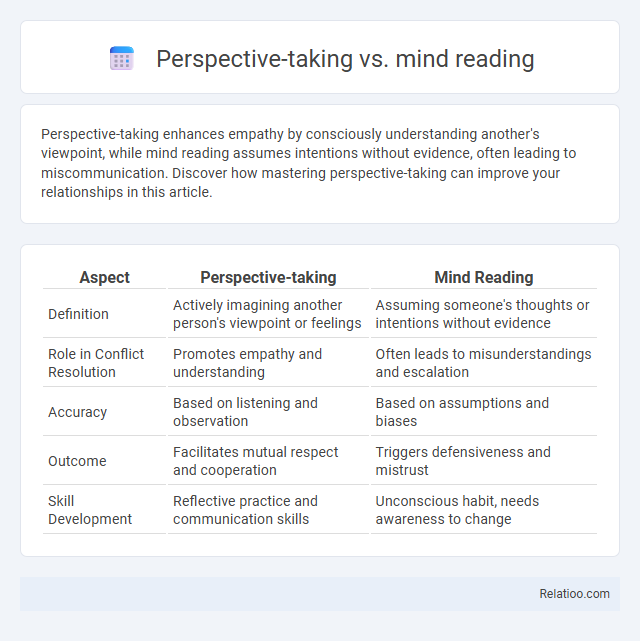Perspective-taking enhances empathy by consciously understanding another's viewpoint, while mind reading assumes intentions without evidence, often leading to miscommunication. Discover how mastering perspective-taking can improve your relationships in this article.
Table of Comparison
| Aspect | Perspective-taking | Mind Reading |
|---|---|---|
| Definition | Actively imagining another person's viewpoint or feelings | Assuming someone's thoughts or intentions without evidence |
| Role in Conflict Resolution | Promotes empathy and understanding | Often leads to misunderstandings and escalation |
| Accuracy | Based on listening and observation | Based on assumptions and biases |
| Outcome | Facilitates mutual respect and cooperation | Triggers defensiveness and mistrust |
| Skill Development | Reflective practice and communication skills | Unconscious habit, needs awareness to change |
Understanding Perspective-Taking
Understanding Perspective-Taking involves recognizing others' viewpoints and emotions without assuming you know their thoughts, which distinguishes it from Mind Reading that attempts to infer specific mental states. Unlike Mind Reading, Perspective-Taking fosters empathy by appreciating diverse experiences rather than guessing intentions. Your ability to accurately engage in Perspective-Taking enhances social interactions and emotional intelligence by promoting genuine understanding.
Defining Mind Reading in Psychology
Mind reading in psychology refers to the cognitive ability to infer another person's thoughts, feelings, or intentions without explicit communication. It involves interpreting nonverbal cues, emotional expressions, and contextual information to predict behavior or mental states. Unlike perspective-taking, which requires imagining oneself in another's position, mind reading centers on decoding mental content directly from observed signals.
Key Differences Between Perspective-Taking and Mind Reading
Perspective-taking involves consciously adopting another person's viewpoint to understand their thoughts and feelings, while mind reading assumes access to someone's internal state without explicit communication. Perspective-taking requires cognitive effort and empathy, fostering accurate comprehension based on observed cues and context, whereas mind reading often leads to assumptions and misunderstandings due to its speculative nature. The key difference lies in perspective-taking's reliance on deliberate interpretation versus mind reading's reliance on unverified inferences.
Cognitive Processes Involved in Both Skills
Perspective-taking involves actively imagining another person's viewpoint, relying on cognitive processes such as empathy, theory of mind, and executive function to understand emotions and intentions. Mind reading, often mistaken for supernatural insight, actually refers to interpreting nonverbal cues and predicting thoughts based on social and contextual information, engaging neural networks linked to social cognition. Your ability to develop both skills depends on enhancing cognitive flexibility, emotional regulation, and metacognitive awareness to accurately comprehend and respond to others' mental states.
The Role of Empathy in Perspective-Taking
Empathy plays a crucial role in perspective-taking by enabling individuals to emotionally understand and share the feelings of others, which goes beyond the cognitive assumptions used in mind reading. While mind reading involves interpreting others' thoughts or intentions based on observable cues, empathy enriches perspective-taking by fostering emotional connection and reducing interpersonal bias. Studies show that higher empathy levels enhance accurate social cognition, improving communication and conflict resolution in various relationships.
Common Misconceptions About Mind Reading
Mind reading is often mistaken for truly understanding someone's thoughts, but it relies on assumptions rather than direct insight, unlike perspective-taking which involves actively considering another's viewpoint. Common misconceptions about mind reading include believing you can accurately know others' intentions without communication, which can lead to misunderstandings and conflicts. Your ability to engage in perspective-taking reduces errors by promoting empathy and open dialogue instead of relying on guesswork.
Practical Benefits of Perspective-Taking
Perspective-taking enhances empathy and interpersonal communication by allowing individuals to understand others' viewpoints without assuming intentions, unlike mind reading, which involves guessing thoughts. This skill improves conflict resolution and collaboration in personal and professional settings by fostering openness and reducing misunderstandings. Practicing perspective-taking leads to stronger relationships and more effective teamwork by encouraging active listening and emotional intelligence.
Challenges and Pitfalls of Mind Reading
Mind reading involves assuming others' thoughts or feelings without clear evidence, which often leads to misunderstandings and inaccurate judgments. Challenges of mind reading include projecting your own biases onto others and misinterpreting nonverbal cues, causing communication breakdowns. Developing your perspective-taking skills encourages empathy and a more accurate understanding of others' viewpoints, reducing the pitfalls of mind reading.
Real-World Applications: Perspective-Taking vs Mind Reading
Perspective-taking involves consciously adopting someone else's viewpoint to understand their thoughts and feelings, while mind reading assumes you instinctively know another's mental state without explicit communication. In real-world applications, perspective-taking enhances empathy, conflict resolution, and effective communication by encouraging deliberate effort, whereas mind reading can lead to misunderstandings and assumptions. Your ability to practice perspective-taking improves interpersonal relationships by fostering clear understanding and reducing misinterpretations.
Strategies to Improve Perspective-Taking and Avoid Mind Reading
Improving perspective-taking requires actively listening and asking clarifying questions to understand others' thoughts and feelings, which prevents inaccurate assumptions commonly seen in mind reading. Practicing empathy by imagining yourself in someone else's situation helps enhance your ability to accurately interpret their point of view without jumping to conclusions. Your daily interactions benefit from these strategies by fostering clearer communication and stronger relationships.

Infographic: Perspective-taking vs Mind Reading
 relatioo.com
relatioo.com